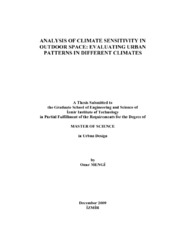Please use this identifier to cite or link to this item:
https://hdl.handle.net/11147/3021Full metadata record
| DC Field | Value | Language |
|---|---|---|
| dc.contributor.advisor | Kaya Erol, Nursen | - |
| dc.contributor.author | Mengi, Onur | - |
| dc.date.accessioned | 2014-07-22T13:50:43Z | - |
| dc.date.available | 2014-07-22T13:50:43Z | - |
| dc.date.issued | 2009 | - |
| dc.identifier.uri | http://hdl.handle.net/11147/3021 | - |
| dc.description | Thesis (Master)--Izmir Institute of Technology, City and Regional Planning, Izmir, 2009 | en_US |
| dc.description | Includes bibliographical references (leaves: 108-114) | en_US |
| dc.description | Text in English; Abstract: Turkish and English | en_US |
| dc.description | xiii, 128 leaves | en_US |
| dc.description.abstract | Many urban design projects we produce today underestimate the design strategies as utilizing the same design criteria for every urban environment regardless their different localities. This problem leads to increasing demands for active heating, cooling and lighting systems, rising energy consumption, declining quality of urban living, environmental deterioration, and expensive and hardly maintained built-up areas.The intention of this study, on one hand, is to present a method of how to examine the climatic factors in an urban area, and on the other hand, is to reconsider urban patterns of Konak Square in Izmir and Kızılay Square in Ankara, from climate sensitive design view point. The overall aim here is to find to what extend designs of the built environment are sensitive to the climate. Specifically, the present study investigates if those urban patterns take the advantage of their particular climate while eliminating the inconveniences.In this framework, the case study was conducted in the summer period, comprising two steps; site surveying and climatic measurements. The findings were processed through the comparison of field measurements with the meteorological data, and the evaluation of the spatial structure in relation to the given comparisons. The study found that Konak Square is more sensitive to the climate comparing to Kızılay Square. The results show that urban pattern of Konak Square takes the advantage of the existing wind conditions, accelerating it throughout the site and decreases air temperature in many locations through its design. | en_US |
| dc.language.iso | en | en_US |
| dc.publisher | Izmir Institute of Technology | en_US |
| dc.rights | info:eu-repo/semantics/openAccess | en_US |
| dc.subject.lcc | HT169.T9 .M54 2009 | en |
| dc.subject.lcsh | City planning--Turkey | en |
| dc.subject.lcsh | Architecture and climate | en |
| dc.title | Analysis of Climate Sensitivity in Outdoor Space: Evaluating Urban Patterns in Different Climates | en_US |
| dc.type | Master Thesis | en_US |
| dc.institutionauthor | Mengi, Onur | - |
| dc.department | Thesis (Master)--İzmir Institute of Technology, City and Regional Planning | en_US |
| dc.relation.publicationcategory | Tez | en_US |
| dc.identifier.wosquality | N/A | - |
| dc.identifier.scopusquality | N/A | - |
| item.openairecristype | http://purl.org/coar/resource_type/c_18cf | - |
| item.cerifentitytype | Publications | - |
| item.fulltext | With Fulltext | - |
| item.languageiso639-1 | en | - |
| item.grantfulltext | open | - |
| item.openairetype | Master Thesis | - |
| Appears in Collections: | Master Degree / Yüksek Lisans Tezleri Sürdürülebilir Yeşil Kampüs Koleksiyonu / Sustainable Green Campus Collection | |
Files in This Item:
| File | Description | Size | Format | |
|---|---|---|---|---|
| T000179.pdf | MasterThesis | 5.68 MB | Adobe PDF |  View/Open |
CORE Recommender
Page view(s)
382
checked on Apr 28, 2025
Download(s)
226
checked on Apr 28, 2025
Google ScholarTM
Check
Items in GCRIS Repository are protected by copyright, with all rights reserved, unless otherwise indicated.